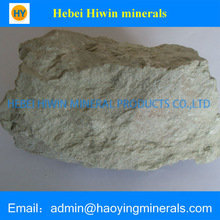kaolin powder
Specifications:
Good particle and uniformity, good whiteness, dispersion,electric insulating, good intermiscibility with resin, high stability
Kaolin, or China clay, is nearly white in color. It is distinguished from other industrial clays based on its fine particle size and pure coloring. Its ability to disperse in water make it an ideal pigment. The primary constituent in kaolin is the mineral kaolinite, a hydrous aluminum silicate formed by the decomposition of minerals such as feldspar.
The name kaolin derives from the Chinese and means high ridge. High ridge is a reference to the hill in south-eastern China where the clay was originally discovered and used. In the 7th and 8th centuries, the Chinese were the first to use kaolin to make porcelain. It was not until centuries later that other areas of the world could duplicate the process.
Chemical Specifications:
SiO2: 46.2%-49%
Al2O3: 32%-37.9%
Fe2O3: 0.8%-0.9%
TiO2: Traces
LOI: 13.2%
CaO: 0.5%-1.36%
MgO: 0.2%-0.6%
MnO: Nil
K2O: 0.34%
Total Alkalies(Na2O): 0.6%-1.0%
Physical Specifications:
Bulk Density: 0.64gm/cc
Oil Absorption: 30%-48%
Acid Soluble matter: 4.97
pH (10% solution): 8
Sp. Gravity: 2.52
%Volatiles at 120oC/hr: Max 2.0
Sp. Gravity at 30oC: 2.60-2.70
Flow Point: 160 -190 ml/100gm
The white color of the mineral can either be naturally occurring, or can result after processing which removes minerals and other color-bearing compounds. The small particle size of the mineral contributes to its white color by scattering light.
Although kaolin is found throughout the world, deposits with suitable whiteness, viscosity and other favorable characteristics are rare. Ironically, the best deposits are not located in China. The Unites States has high-quality deposits in the Southeast. The mineral has been mined since colonial times in Georgia and South Carolina. Other valuable deposits are located in Brazil and the United Kingdom.
Uses of China Clay:
China, Porcelain and Tableware – Many people are under the mistaken impression that the only use for kaolin is in the manufacture of china. This is not true, and its use by the paper industry far exceeds its other uses. However, kaolin still serves as a valuable component in china and other tablewares. Its color, gloss and hardness are ideal characteristics for such products.
Paper Industry – The primary use of kaolin is in the paper industry. It serves as a paper coating which improves appearance by contributing to brightness, smoothness and gloss. It also improves printability. Additionally, it is used by the paper industry as a filler reducing cost and the use of tree-based resources
Other Uses – Kaolin has a variety of other uses in products including paint, rubber, cable insulation, specialty films and fertilizers. New uses are being discovered frequently, and ensure that the mineral will remain in demand for a long time.





















 在线聊天
在线聊天

























